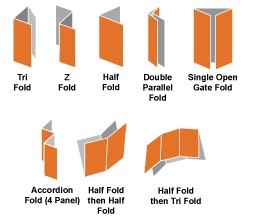

Use our online designer studio to create your own personalised flyers, business cards, greeting cards and more.
Order NowWhen it comes to professional printing and advice on your business marketing, we are the team to call! You can call us direct on 04 568 8773 or fill in our quote form.
Request a Quote
We are going to talk about creasing and folding: what is, how we do it, what types can and can’t be done, and how you design for it. The subject can be quite lengthy and complex so consider this more a basic introduction to the subject. But why should you care? To put it simply, creasing and folding allows you to fit more information into a smaller space. Consider the old fashioned paper maps and how big they are and then get get folded down to something will fit in a glove compartment. Folding is often a cheaper solution to having more ‘pages’ for a printed item. Consider something as simple as a four page newsletter. Doing it a two double sided A4 with a corner staple, you’re paying for 4 A4 printing clicks, two sheets of paper and a staple; while the same info printed on a single double-sided A3 sheet folded into half will faster and easier to produce. So let’s talk about what creasing and folding is and what it can do for you.
What is folding?
Folding is where a machine will take the finished sheet of paper moving in one direction over a pair of plates set at right angles, stop it and force to move in the opposite direction over the plates causing the paper to bend and fold onto itself. This process can be repeated several times on one sheet of paper depending on it’s weight and how many layers of paper the machine has to fold.
What is creasing?
Creasing moves the sheet of paper or card over a plate with a groove in it. A metal bar will press that paper into the groove, stretching it by a small amount making a crease where the paper will fold naturally. Depending on what is being done, a single sheet of paper can have multiple creases in different directions.
What’s the difference between creasing and folding?
bout 170gsm it become quite hard to fold in two unless you are using very specialized equipment, so in these situations most printing companies, including ourselves, just crease it and supply it to you flat. Material that is creased but still flat takes up a lot less space in storage than when it’s folded too. If you want to cross fold, then you are liIt boils down to practical limitations of being able to bend the paper fibers. Once paper gets to the stiffness of amited to 100gsm at best.
Why do you charge for both on some jobs?
When you have paper that has a very high ink/toner coverage then fold it, the printing can show cracks/splits from the either the toner splitting or the paper fibers breaking, giving you visible white spots. By creasing it first, the paper and printing is stretched and then can fold with much less risk of cracking.
How many folds and creases can you do?
In theory as many as you want, in practical terms the more folds and creases you do the high chance of it going wrong. For folding the limit is 2-3 on any any sheet of paper depending on the type of fold being done. For creasing we are limited to 4 creases per item.
So what kind of folding and creasing can you do?
Copy Express can fold in a lot of different ways but here’s the most common
We can do all different sized sections in the fold so you can have different widths in each panel. Great for things like landscape A3’s that are Z folded to A4 by having the left hand section 210mm wide and the other two sections 105mm each, making them fit easy into any bound book. Creasing is only limited that the ‘leading’ panel of any item must be at least 25mm wide, after that the panels can be as small as you like but allow for the fact the creasing bar takes up 2mm of paper every time.
So anything to be aware of if I’m designing something to be folded or creased.
Firstly never design with the assumption that your artwork to start or finish on a crease or fold because we can’t guarantee that the finished item will. Because it will be part of a long production chain of mechanical steps ( printing, cutting, folding) there is a risk of things shifting slightly out of alignment during each step. While we have that variance down to no more than 0.5mm per step, that risk is still there so allow for that in your design. Secondly remember that if you are overlapping pages in a fold, the roll fold being the most common example, you have to factor in the thickness of the paper and that one panel has to fit inside the others. Logically a roll folded A4 would have three panels of 99mm wide but that would result in the inner flap bumping or being bent by the outer fold, so we fold the outer and center panels to 100mm wide and have the inner one at 97mm. Finally every company does their folds slightly differently. As we do roll folded A4 one way, another company will do it with panels 100-99.5-97.5, while a third would do it 99-99-97 trimming off the last panel by 2mm. So check with your printer how they will be doing it when you are making up a design to be done for a particular print system and paper.
That’s it for now about folding and creasing. If you want to find out more why not give us a call and we can help you with setting up that next exciting product.